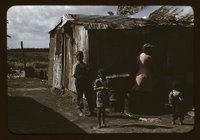In Color
 I recently came across an online exhibit entitled, “America from the Great Depression to World War II: Color Photographs from the Farm Security Administration-Office of War Information Collection, 1939-1945.” The collection of over 1500 images taken by New Deal photographers resides in the archives of the Library of Congress, which is displaying a selection of them at the Thomas Jefferson Building, located across from the Capitol, through January 21.
I recently came across an online exhibit entitled, “America from the Great Depression to World War II: Color Photographs from the Farm Security Administration-Office of War Information Collection, 1939-1945.” The collection of over 1500 images taken by New Deal photographers resides in the archives of the Library of Congress, which is displaying a selection of them at the Thomas Jefferson Building, located across from the Capitol, through January 21. The archive contains some of the most amazing and moving images of everyday life in Depression-era America that I have ever seen. That the photographs are in color gives the scenes captured in them a realism and a familiarity often lacking in black & white photographs from the same period.
The result is a world that is both familiar and foreign. I find that the colors emphasize that world’s tangibility and physicality—the material culture to which one’s eyes are instinctively drawn when viewing old photographs. At the same time, many of the photographs show a world lacking in material comforts. Poverty—both urban and rural—is a thread that runs throughout much of the exhibit.
 I highly recommend taking some time to peruse this exhibit online. Among the most haunting images are those that show life among impoverished sharecroppers in the rural South. Even with the lingering effects of the Great Depression, Americans of sixty years ago were shocked by what they saw in these photographs. Just like Americans several months ago were shocked by what they saw on their television sets in the aftermath of Hurricane Katrina, which once again drew our attention to the existence of America’s underclass. For a brief moment, we were reminded of the plight of the poor in our midst; and like Americans of sixty years ago, we’ve probably already forgotten.
I highly recommend taking some time to peruse this exhibit online. Among the most haunting images are those that show life among impoverished sharecroppers in the rural South. Even with the lingering effects of the Great Depression, Americans of sixty years ago were shocked by what they saw in these photographs. Just like Americans several months ago were shocked by what they saw on their television sets in the aftermath of Hurricane Katrina, which once again drew our attention to the existence of America’s underclass. For a brief moment, we were reminded of the plight of the poor in our midst; and like Americans of sixty years ago, we’ve probably already forgotten.












0 Comments:
Post a Comment
<< Home